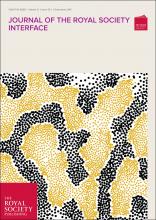Journal of the Royal Society Interface facts for kids
 |
|
|
Abbreviated title (ISO 4)
|
J. R. Soc. Interface |
|---|---|
| Discipline | Interdisciplinary |
| Language | English |
| Edited by | Richard Cogdell |
| Publication details | |
| Publisher |
The Royal Society (United Kingdom)
|
|
Publication history
|
2004–present |
| Frequency | Monthly |
|
Open access
|
Hybrid |
|
Impact factor
(2022) |
3.9 |
| Indexing | |
| ISSN | 1742-5689 (print) 1742-5662 (web) |
| CODEN | JRSICU |
| OCLC no. | 711051718 |
| Links | |
|
|
The Journal of the Royal Society Interface is a special magazine for scientists. It comes out every month. This journal shares new discoveries where different science fields meet. It brings together ideas from life sciences (like biology) and physical sciences (like physics and chemistry).
Contents
About the Journal of the Royal Society Interface
This journal is a scientific journal. It publishes new research papers. These papers are checked by other experts before they are published. This process is called peer review. It helps make sure the science is good and correct.
The journal focuses on the "interface" between different sciences. This means it looks at how life sciences and physical sciences connect. For example, it might publish research about how physics helps us understand how our bodies work. Or how chemistry can create new materials for medicine.
What Sciences Does It Cover?
The journal covers many exciting areas. It includes chemistry, engineering, and materials science. It also features mathematics and physics. All these fields come together to solve big scientific questions.
Who Publishes It?
The Journal of the Royal Society Interface started in 2004. It is published by The Royal Society. This is a very old and famous scientific group in the United Kingdom. The main editor, who leads the journal, is Richard Cogdell. He works at the University of Glasgow.
Where to Find the Journal
This journal is easy to find in many science libraries. It is listed in important science databases. These include the Science Citation Index and Scopus. This means scientists all over the world can read its articles.

